Grid Dynamics Bundle
Who Really Owns Grid Dynamics?
Understanding the ownership structure of a company is critical for investors and analysts alike. Grid Dynamics, a key player in digital engineering, has seen its ownership evolve significantly, especially after its public listing. This article dives deep into the Grid Dynamics SWOT Analysis, exploring the key players and their influence on the company's future.
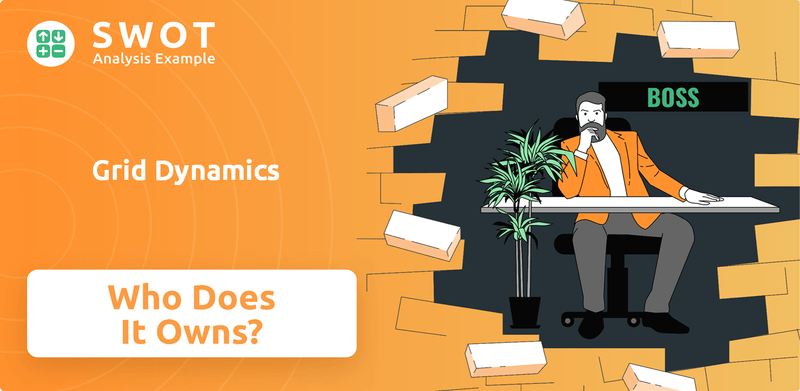
Grid Dynamics, a publicly traded company since its IPO on March 5, 2020, has a dynamic ownership landscape. This analysis will explore the shifts in Grid Dynamics ownership, identifying the major Grid Dynamics shareholders and their impact on the company's strategic direction. From its founders to its current institutional investors, we'll examine the forces shaping Grid Dynamics' trajectory, including its market cap and financial performance, providing insights for anyone interested in Grid Dynamics stock.
Who Founded Grid Dynamics?
The story of Grid Dynamics begins in 2006, marking the genesis of a company that would evolve into a significant player in the digital transformation space. While specific details about the initial ownership structure among the founders are not readily available in public records, the early years were marked by strategic investments and the pursuit of growth.
Early-stage venture capital played a crucial role in shaping Grid Dynamics. BGV, a venture capital firm, was an early investor. Eric Benhamou, a founder and general partner at BGV, highlighted their involvement in preparing the company for its initial public offering (IPO), indicating a strategic partnership aimed at long-term value creation.
The transition from a privately held startup to a publicly traded company, as Grid Dynamics undertook, typically involves changes in the ownership structure. This includes the dilution of founder stakes as new shares are issued to a broader base of investors. This shift is a natural part of the growth trajectory for many tech companies.
Early investors like BGV provided crucial capital and strategic guidance.
Initial equity distribution among founders is not publicly disclosed.
Agreements like vesting schedules would have been in place to manage founder equity.
The IPO process typically leads to a dilution of founder ownership.
Details on early agreements are not available in public domain.
Early partnerships helped in preparing the company for its public listing.
Understanding the early ownership structure of Grid Dynamics, including the role of venture capital and the impact of the IPO, provides valuable context for analyzing the current Target Market of Grid Dynamics and its position in the market. Key points include:
- Grid Dynamics was founded in 2006.
- Early investment from firms like BGV supported growth.
- The IPO process changed the ownership structure.
- Details of founder equity are not publicly available.
- The company's financial performance and stock are key for investors.
Grid Dynamics SWOT Analysis
- Complete SWOT Breakdown
- Fully Customizable
- Editable in Excel & Word
- Professional Formatting
- Investor-Ready Format
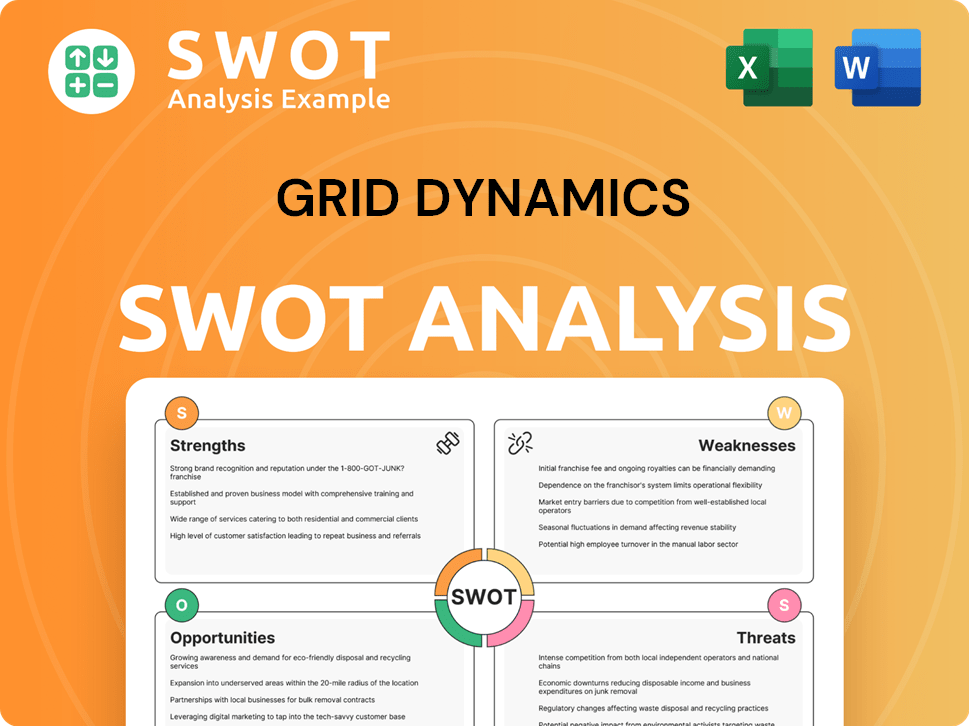
How Has Grid Dynamics’s Ownership Changed Over Time?
The journey of Grid Dynamics from a private entity to a publicly traded company marks a significant shift in its ownership structure. The company went public on March 5, 2020, through a merger with ChaSerg, a special purpose acquisition company (SPAC). This strategic move, which listed the company on NASDAQ under the ticker symbol GDYN, was a pivotal moment.
At the time of its initial public offering (IPO), the company's market capitalization was approximately $600 million, based on a stock price of $12.00 per share. This transition to a public entity opened the doors for a broader range of investors, including institutional investors, mutual funds, and individual investors, to acquire shares in the company. This shift had a direct impact on the company's governance and strategic direction, aligning it more closely with market expectations and shareholder value.
| Ownership Category | Approximate Percentage (May 2025) | Key Details |
|---|---|---|
| Institutional Investors | 83.01% | Hold a substantial majority of the shares, indicating strong confidence from major financial institutions. |
| Mutual Funds | 60.69% | Significant portion held by mutual funds, reflecting broad investor interest. |
| Beijing Teamsun Technology Co. Ltd. | Approximately 20.0% | A Chinese company, a significant minority shareholder. |
| Other Major Shareholders (June 2025) | Various | Includes BlackRock, Inc., Vanguard Group Inc, Wasatch Advisors Inc, and State Street Corp. |
| Leonard Livschitz (CEO) | Approximately 3,036,469 shares (May 22, 2025) | A key insider shareholder, demonstrating alignment with company performance. |
As of June 13, 2025, the market capitalization of Grid Dynamics reached $971 million. The shift towards public ownership, coupled with the presence of large institutional investors, typically influences a company's strategy. This often leads to enhanced transparency, a stronger focus on meeting market expectations, and an increased emphasis on creating value for shareholders. The current ownership structure of Grid Dynamics, with its mix of institutional and individual investors, reflects a dynamic environment that is subject to change based on market conditions and strategic decisions.
The majority of Grid Dynamics is held by institutional investors and mutual funds.
- The IPO in March 2020 was a pivotal moment.
- Beijing Teamsun Technology Co. Ltd. is a significant minority shareholder.
- The CEO, Leonard Livschitz, holds a substantial number of shares.
- The company's market capitalization is currently at $971 million (June 13, 2025).
Grid Dynamics PESTLE Analysis
- Covers All 6 PESTLE Categories
- No Research Needed – Save Hours of Work
- Built by Experts, Trusted by Consultants
- Instant Download, Ready to Use
- 100% Editable, Fully Customizable
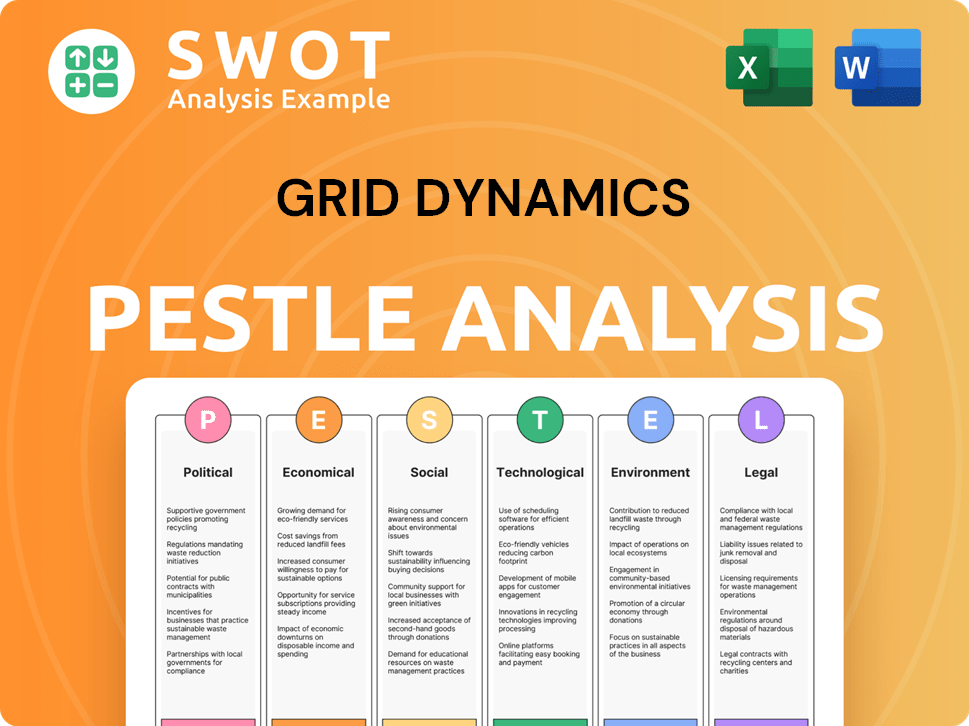
Who Sits on Grid Dynamics’s Board?
The Board of Directors of Grid Dynamics is responsible for overseeing the company's strategic direction and governance. The composition of the board typically includes a mix of individuals, such as company executives, representatives of major shareholders, and independent directors. Details on board members' affiliations and backgrounds are usually found in the company's filings with the Securities and Exchange Commission (SEC), including proxy statements. For instance, Mr. Wang Weihang, Chairman of the Board of Directors of ASL (Automated Systems Holdings Limited), and Mr. Leon Wang, Executive Director and Chief Executive Officer of ASL, were appointed as members of Grid Dynamics' new Board of Directors following the IPO, reflecting ASL's position as a significant early shareholder through Beijing Teamsun Technology Co. Ltd.
The board's role is crucial in representing the interests of all Grid Dynamics shareholders. The board's composition can be influenced by various factors, including significant shareholder positions and proxy battles. The company's annual meeting of stockholders is a key event where shareholders exercise their voting rights, including electing the Board of Directors. The 2024 Annual Meeting of Stockholders was held on December 23, 2024.
| Board Member | Title | Affiliation |
|---|---|---|
| Leonard Livschitz | Chief Executive Officer | Grid Dynamics |
| Anatoly Motkin | Chairman of the Board | Grid Dynamics |
| Eran Geller | Director | Independent |
Grid Dynamics operates with a standard voting structure, where each share of common stock generally entitles the holder to one vote. Information on specific voting rights, including any dual-class shares, is detailed in SEC filings such as the 10-K and proxy statements. As a publicly traded company, Grid Dynamics is subject to regulations regarding proxy battles and activist investor campaigns, which can impact decision-making and board composition. For more insights into the company's evolution, consider reading the Brief History of Grid Dynamics.
Shareholders of Grid Dynamics exercise their voting rights at the annual meeting. The board of directors is elected by the shareholders. The voting structure is typically one vote per share.
- Board members' affiliations are disclosed in SEC filings.
- The annual meeting is a key event for shareholder voting.
- Proxy battles can influence board composition.
- The company's governance is shaped by shareholder votes.
Grid Dynamics Business Model Canvas
- Complete 9-Block Business Model Canvas
- Effortlessly Communicate Your Business Strategy
- Investor-Ready BMC Format
- 100% Editable and Customizable
- Clear and Structured Layout
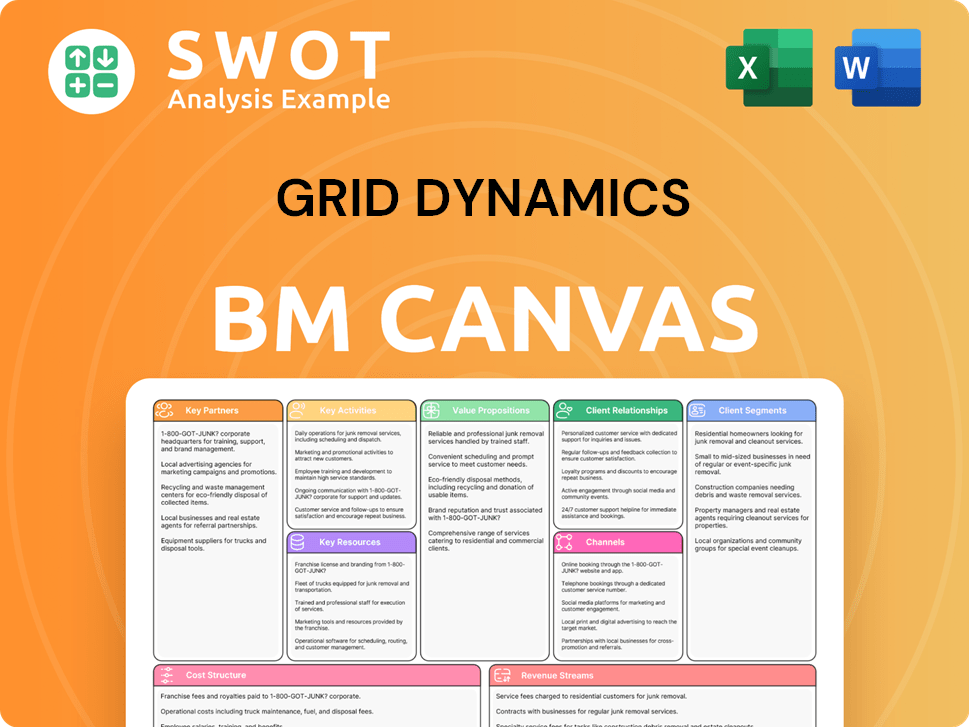
What Recent Changes Have Shaped Grid Dynamics’s Ownership Landscape?
Over the past few years, several developments have shaped the ownership landscape of Grid Dynamics. A notable event was the November 2024 announcement of a public offering, where the company priced an underwritten offering of 5,750,000 shares of its common stock. This offering aimed to raise approximately $93.4 million in net proceeds, which the company plans to use for working capital, capital expenditures, and potential acquisitions. This action diluted existing shareholders' stakes but also provided capital for expansion.
The company's strategic moves, such as acquiring JUXT in the UK and Mobile Computing in Argentina, have also had an impact. These acquisitions may lead to changes in ownership, either through equity components in the deals or by influencing the company's financial performance. These changes can affect investor sentiment and the Grid Dynamics stock price.
| Metric | Details | Date |
|---|---|---|
| Institutional Ownership | Remained at 83.01% | May 2025 |
| Mutual Fund Ownership | Held 60.69% | May 2025 |
| Projected Revenue | Between $415.0 to $435.0 million | Full-year 2025 |
| Revenue Growth | 18.4% to 24.1% over 2024 | Full-year 2025 |
Industry trends indicate a growing interest from institutional investors in technology companies like Grid Dynamics. Insider trading activities, such as sales by CEO Leonard Livschitz in May 2025 and February 2025, are regularly reported. Furthermore, Grid Dynamics joined the S&P SmallCap 600 index on January 2, 2025, which often leads to increased investment from index funds. The company's projected revenue growth for 2025, estimated between $415.0 and $435.0 million, which represents an increase of 18.4% to 24.1% compared to 2024, suggests a positive outlook that could further influence ownership trends. For more information about the company's strategic direction, you can read about the Growth Strategy of Grid Dynamics.
The company has been active with acquisitions, such as JUXT and Mobile Computing, which are being integrated.
Institutional ownership has remained high, with mutual funds holding a significant portion of the shares.
The company projects substantial revenue growth for 2025, indicating a positive financial outlook.
Joining the S&P SmallCap 600 index can lead to increased investment from index funds.
Grid Dynamics Porter's Five Forces Analysis
- Covers All 5 Competitive Forces in Detail
- Structured for Consultants, Students, and Founders
- 100% Editable in Microsoft Word & Excel
- Instant Digital Download – Use Immediately
- Compatible with Mac & PC – Fully Unlocked
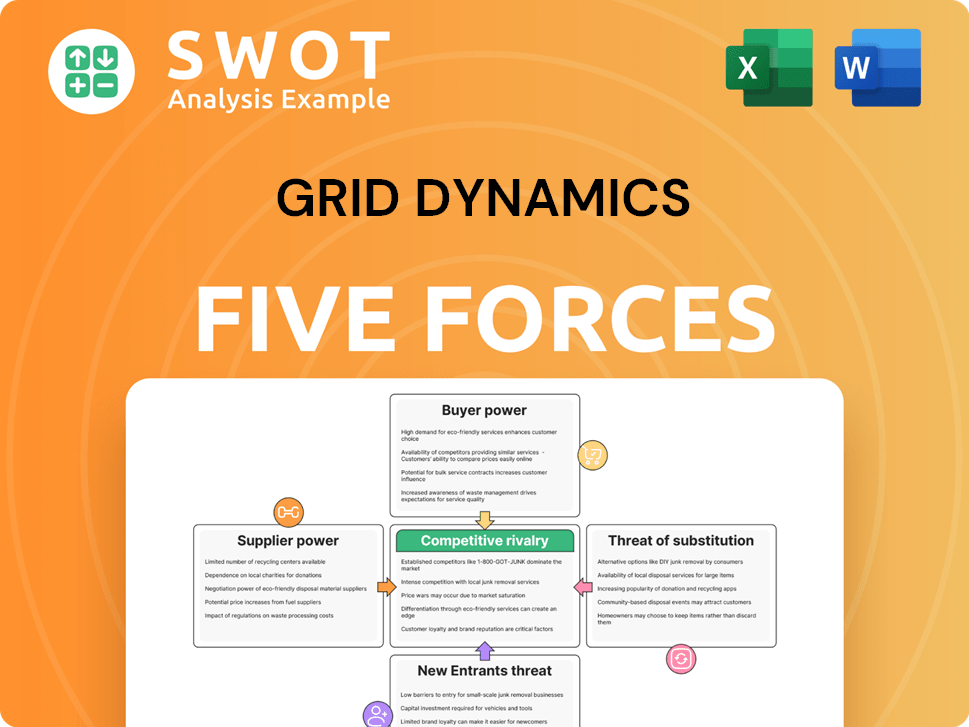
Related Blogs
- What are Mission Vision & Core Values of Grid Dynamics Company?
- What is Competitive Landscape of Grid Dynamics Company?
- What is Growth Strategy and Future Prospects of Grid Dynamics Company?
- How Does Grid Dynamics Company Work?
- What is Sales and Marketing Strategy of Grid Dynamics Company?
- What is Brief History of Grid Dynamics Company?
- What is Customer Demographics and Target Market of Grid Dynamics Company?
Disclaimer
All information, articles, and product details provided on this website are for general informational and educational purposes only. We do not claim any ownership over, nor do we intend to infringe upon, any trademarks, copyrights, logos, brand names, or other intellectual property mentioned or depicted on this site. Such intellectual property remains the property of its respective owners, and any references here are made solely for identification or informational purposes, without implying any affiliation, endorsement, or partnership.
We make no representations or warranties, express or implied, regarding the accuracy, completeness, or suitability of any content or products presented. Nothing on this website should be construed as legal, tax, investment, financial, medical, or other professional advice. In addition, no part of this site—including articles or product references—constitutes a solicitation, recommendation, endorsement, advertisement, or offer to buy or sell any securities, franchises, or other financial instruments, particularly in jurisdictions where such activity would be unlawful.
All content is of a general nature and may not address the specific circumstances of any individual or entity. It is not a substitute for professional advice or services. Any actions you take based on the information provided here are strictly at your own risk. You accept full responsibility for any decisions or outcomes arising from your use of this website and agree to release us from any liability in connection with your use of, or reliance upon, the content or products found herein.